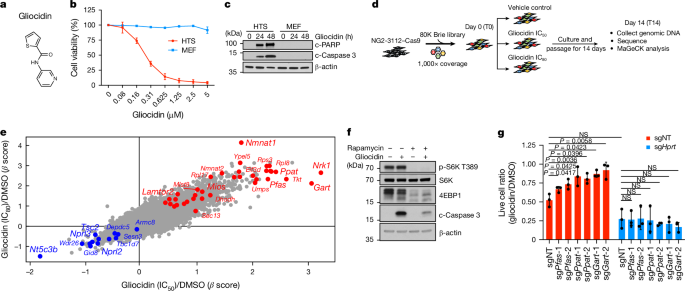Xie, X. P. et al. Quiescent human glioblastoma cancer stem cells drive tumor initiation, expansion, and recurrence following chemotherapy. Dev. Cell 57, 32â46 (2022).
Valvezan, A. J. et al. IMPDH inhibitors for antitumor therapy in tuberous sclerosis complex. JCI Insight 5, e135071 (2020).
Johnson, M. C. & Kollman, J. M. Cryo-EM structures demonstrate human IMPDH2 filament assembly tunes allosteric regulation. eLife 9, e53243 (2020).
Lim, M. et al. Phase III trial of chemoradiotherapy with temozolomide plus nivolumab or placebo for newly diagnosed glioblastoma with methylated MGMT promoter. Neuro Oncol. 24, 1935â1949 (2022).
Reardon, D. A. et al. Effect of nivolumab vs bevacizumab in patients with recurrent glioblastoma: the CheckMate 143 phase 3 randomized clinical trial. JAMA Oncol. 6, 1003â1010 (2020).
Shi, Y. et al. Gboxin is an oxidative phosphorylation inhibitor that targets glioblastoma. Nature 567, 341â346 (2019).
Kwon, C. H. et al. Pten haploinsufficiency accelerates formation of high-grade astrocytomas. Cancer Res. 68, 3286â3294 (2008).
Doench, J. G. et al. Optimized sgRNA design to maximize activity and minimize off-target effects of CRISPRâCas9. Nat. Biotechnol. 34, 184â191 (2016).
Saxton, R. A. & Sabatini, D. M. mTOR signaling in growth, metabolism, and disease. Cell 168, 960â976 (2017).
Valvezan, A. J. et al. mTORC1 couples nucleotide synthesis to nucleotide demand resulting in a targetable metabolic vulnerability. Cancer Cell 32, 624â638 (2017).
Bester, A. C. et al. Nucleotide deficiency promotes genomic instability in early stages of cancer development. Cell 145, 435â446 (2011).
Bieganowski, P. & Brenner, C. Discoveries of nicotinamide riboside as a nutrient and conserved NRK genes establish a PreissâHandler independent route to NAD+ in fungi and humans. Cell 117, 495â502 (2004).
Cooney, D. A. et al. Studies on the mechanism of action of tiazofurin metabolism to an analog of NAD with potent IMP dehydrogenase-inhibitory activity. Adv. Enzyme Regul. 21, 271â303 (1983).
Monecke, T. et al. Crystal structures of the novel cytosolic 5â²-nucleotidase IIIB explain its preference for m7GMP. PLoS ONE 9, e90915 (2014).
Pastor-Anglada, M. & Perez-Torras, S. Emerging roles of nucleoside transporters. Front. Pharmacol. 9, 606 (2018).
Hedstrom, L. IMP dehydrogenase: structure, mechanism, and inhibition. Chem. Rev. 109, 2903â2928 (2009).
Sintchak, M. D. et al. Structure and mechanism of inosine monophosphate dehydrogenase in complex with the immunosuppressant mycophenolic acid. Cell 85, 921â930 (1996).
Chau, V. et al. Preclinical therapeutic efficacy of a novel pharmacologic inducer of apoptosis in malignant peripheral nerve sheath tumors. Cancer Res. 74, 586â597 (2014).
Song, T. et al. The NAD+ synthesis enzyme nicotinamide mononucleotide adenylyltransferase (NMNAT1) regulates ribosomal RNA transcription. J. Biol. Chem. 288, 20908â20917 (2013).
Shireman, J. M. et al. De novo purine biosynthesis is a major driver of chemoresistance in glioblastoma. Brain 144, 1230â1246 (2021).
Kofuji, S. et al. IMP dehydrogenase-2 drives aberrant nucleolar activity and promotes tumorigenesis in glioblastoma. Nat. Cell Biol. 21, 1003â1014 (2019).
Aibar, S. et al. SCENIC: single-cell regulatory network inference and clustering. Nat. Methods 14, 1083â1086 (2017).
Alquicira-Hernandez, J. & Powell, J. E. Nebulosa recovers single-cell gene expression signals by kernel density estimation. Bioinformatics 37, 2485â2487 (2021).
Tirosh, I. et al. Dissecting the multicellular ecosystem of metastatic melanoma by single-cell RNA-seq. Science 352, 189â196 (2016).
Chambers, M. C. et al. A cross-platform toolkit for mass spectrometry and proteomics. Nat. Biotechnol. 30, 918â920 (2012).
Pluskal, T. et al. MZmine 2: modular framework for processing, visualizing, and analyzing mass spectrometry-based molecular profile data. BMC Bioinformatics 11, 395 (2010).
Mastronarde, D. N. Automated electron microscope tomography using robust prediction of specimen movements. J. Struct. Biol. 152, 36â51 (2005).
Punjani, A. et al. cryoSPARC: algorithms for rapid unsupervised cryo-EM structure determination. Nat. Methods 14, 290â296 (2017).
Bepler, T. et al. Positive-unlabeled convolutional neural networks for particle picking in cryo-electron micrographs. Nat. Methods 16, 1153â1160 (2019).
Terwilliger, T. C. et al. Improvement of cryo-EM maps by density modification. Nat. Methods 17, 923â927 (2020).
Pettersen, E. F. et al. UCSF Chimeraâa visualization system for exploratory research and analysis. J. Comput. Chem. 25, 1605â1612 (2004).
Moriarty, N. W., Grosse-Kunstleve, R. W. & Adams, P. D. electronic Ligand Builder and Optimization Workbench (eLBOW): a tool for ligand coordinate and restraint generation. Acta Crystallogr. D Biol. Crystallogr. 65, 1074â1080 (2009).
Emsley, P. et al. Features and development of Coot. Acta Crystallogr. D Biol. Crystallogr. 66, 486â501 (2010).
Afonine, P. V. et al. Real-space refinement in PHENIX for cryo-EM and crystallography. Acta Crystallogr. D Struct. Biol. 74, 531â544 (2018).
Davis, I. W. et al. MolProbity: all-atom contacts and structure validation for proteins and nucleic acids. Nucleic Acids Res. 35, W375âW383 (2007).
Zhang, J. et al. Design, synthesis, and evaluation of inhibitors for severe acute respiratory syndrome 3C-like protease based on phthalhydrazide ketones or heteroaromatic esters. J. Med. Chem. 50, 1850â1864 (2007).
Bollenbach, M. et al. Efficient and mild Ullmann-type N-arylation of amides, carbamates, and azoles in water. Chemistry 23, 13676â13683 (2017).
Ikawa, T. et al. Pd-catalyzed amidation of aryl chlorides using monodentate biaryl phosphine ligands: a kinetic, computational, and synthetic investigation. J. Am. Chem. Soc. 129, 13001â13007 (2007).
Ganbold, M. Gliocidin. Zenodo https://doi.org/10.5281/zenodo.13845197 (2024).


